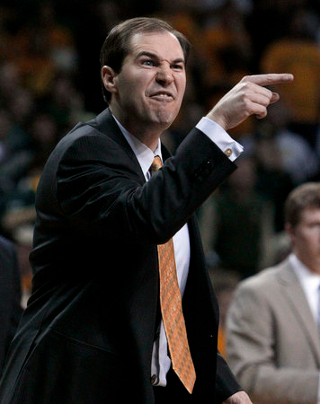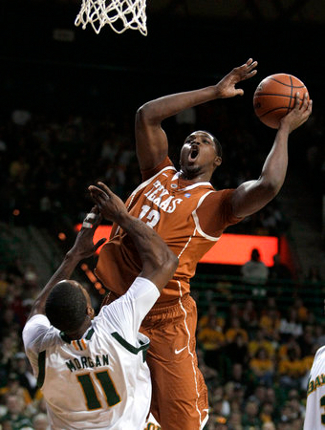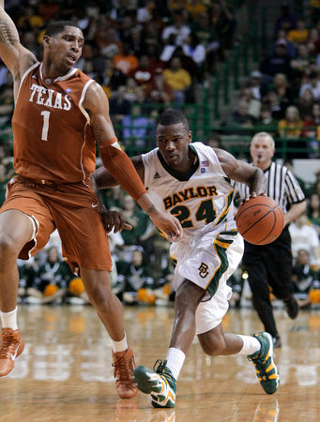Scott Drew wants Rick Barnes at the flagpole at 3:30 It was far from pretty. But after losing three of their last four games, the Longhorns were willing to take any win they could get. Texas finally ended its road woes last night, winning in Waco for the team’s first victory away from the Erwin Center since beating Oklahoma in Norman on February 9th. The Horns overcame 35% shooting from the field, capitalizing on an excellent rebounding performance to gut out a 60-54 win over Baylor. The loss was much bigger for the Bears than the win was for the Longhorns. Texas was already locked into the Big 12’s second seed in the upcoming conference tournament, while the Bears entered the game as one of Joe Lunardi’s projected “First Four Out” of the NCAA field. Following the defeat, Baylor was still entrenched in that dreaded group, as other bubble teams failed to secure convincing wins. Fortunately for the Bears, they can get another crack at Texas. Thanks to a late season win against Nebraska, Baylor owned the tiebreaker over the Cornhuskers and earned the league’s 7th seed in the conference tournament. Now they only have to beat 10th-seeded Oklahoma in order to face Texas in the tournament quarterfinals on Thursday night. At just 7-9 in league play, with just a pair of victories over Texas A&M to hang their hat on, even a win in that game might not be enough for the Bears. What looked good In a game that had just 45 combined points in the first half, there wasn’t much that looked exceptionally good. Much of the ugliness on the court was caused by the long-awaited return of Texas’ stifling defense. The Longhorns limited Baylor to just 0.915 points per possession, only the second time in the last five games that Texas was able to keep an opponent under one point per trip. The other came against the league’s cellar-dweller, Iowa State, who managed only 0.767 points per possession in Austin last week.
Tristan Thompson was too much for Baylor to handle While the Texas defense was finally making its reappearance, the offense was struggling. Tristan Thompson managed to keep Texas afloat in the first half, however, dominating the offensive glass and piling up second chance points. Thompson finished the game with 19 points and 13 rebounds, with eight of those boards coming on the offensive end. Thompson’s rebounding percentage on the offensive glass was an insane 22.8%, the first time he had even cracked the 15% mark since beating Missouri in early January. As a point of reference, the nation’s best offensive rebounder — Morehead State’s Kenneth Faried — is averaging a 20.1% success rate on offensive rebounding opportunities against his overmatched Ohio Valley foes. Thompson wasn’t the only one dominating the rebounding battle. As a team, the Longhorns grabbed more than 51% of their missed shots, which resulted in quite a few boards thanks to their 38 missed shots on the night. In the first half, Texas reclaimed 44% of their offensive rebounding opportunities, and did an even better job out-muscling the Bears in the second half. The Longhorns secured 12 offensive boards in the final twenty minutes, while Baylor grabbed just eight defensive rebounds. A big part of Texas’ late-game success was clutch play from Alexis Wangmene. He played only 11 minutes in the game, but grabbed five offensive boards, including three in the final three minutes. He earned four attempts at the line, and sunk all of them, a huge feat for any Longhorn. The team made just 59.3% of their free throw attempts on the night, and just 52.2% if you take Wangmene’s makes out of the equation. With the game still in doubt and less than a minute on the clock, Wangmene managed to grab his most important rebound off a missed jumper by Cory Joseph. The Horns kicked it out to the sure-shooting J’Covan Brown, who essentially iced the game with a pair of free throws. Although Alexis doesn’t get credit on the stat sheet for those points, the much-maligned reserve was instrumental in preserving the win. The other player who must be singled out for an impressive performance is Gary Johnson. Playing in his final regular season game, Johnson did it all on both ends of the court. In addition to eight big rebounds, Johnson also had a pair of clutch jumpers that kept Texas in the game early in the second half when it looked like Baylor was going to run away with it. Most important, however, was his surprising defense on Baylor’s LaceDarius Dunn, who was becoming a one-man wrecking crew coming out of halftime. Early in the second half, Dunn drilled a three-pointer with Balbay in his face. Texas responded on the next possession, as Joseph left A.J. Walton to double Dunn. The extra attention backfired, as it allowed Walton to get an easy putback on a weakside rebound. Two possessions later, Anthony Jones had a wide-open three because Joseph again elected to double Dunn instead of sticking with Walton, and Baylor’s quick ball reversal around the perimeter led to the easy triple. LaceDarius followed all of that with another bucket on the ensuing possession, and the Bears were suddenly up by nine.
Gary Johnson slowed down Dunn in the second half Coming out of the under-16 media timeout, Rick Barnes gave Gary Johnson the difficult task of sticking with Baylor’s superstar. Where Dunn could once pop ridiculous shots with Balbay in his face, he now had to deal with a 6’6″ defender. Beyond just the height advantage, Johnson also showed incredible athleticism and hustle in sticking with Dunn through screen after screen, limiting his ability to find the space to shoot. With Johnson defending him, Dunn had a scoreless stretch of more than seven minutes, and went just 2-for-9 the rest of the game. What needed work Unfortunately for the Longhorns, a big part of their early struggles was the continued difficulty for Jordan Hamilton on the offensive end. He was just 1-for-7 from the field in the first half, with his only basket coming on a dunk. Two of his misses were on ugly, forced shots, and he passed up open looks inside by trying to make unnecessary interior passes to the blocks. Those extra passes inside were indicative of a larger problem for Texas, namely that the team looked incredibly tight in the first half. The Longhorns had a few early possessions where they actually penetrated the zone or made the pass into the soft middle. But instead of being assertive with the basketball and taking the shot or making the quick pass, the players seemed to be too concerned with not making mistakes. That indecision let Baylor recover, and Texas was forced into long, ugly possessions that typically ended in bad looks. As always, free throws were an albatross for the Longhorns. As previously mentioned, the team shot below 60% at the line, the 11th time they have been below that watermark in their 31 games. Add in the fact that Texas missed the front end on three different one-and-one attempts, and that’s a ton of potential points the team left on the line. While it’s a known fact that Thompson is going to struggle from the line — and that he gets to the line more frequently than the rest of the team — the troubling thing is that J’Covan Brown and Cory Joseph were the culprits on two of those wasted one-and-ones. When even the guards are struggling at the line, Texas is going to have some major issues with offensive efficiency. Up next: Big 12 Tournament Quarterfinal vs. Baylor or Oklahoma (in Kansas City); Thursday, 6 P.M. CT |











